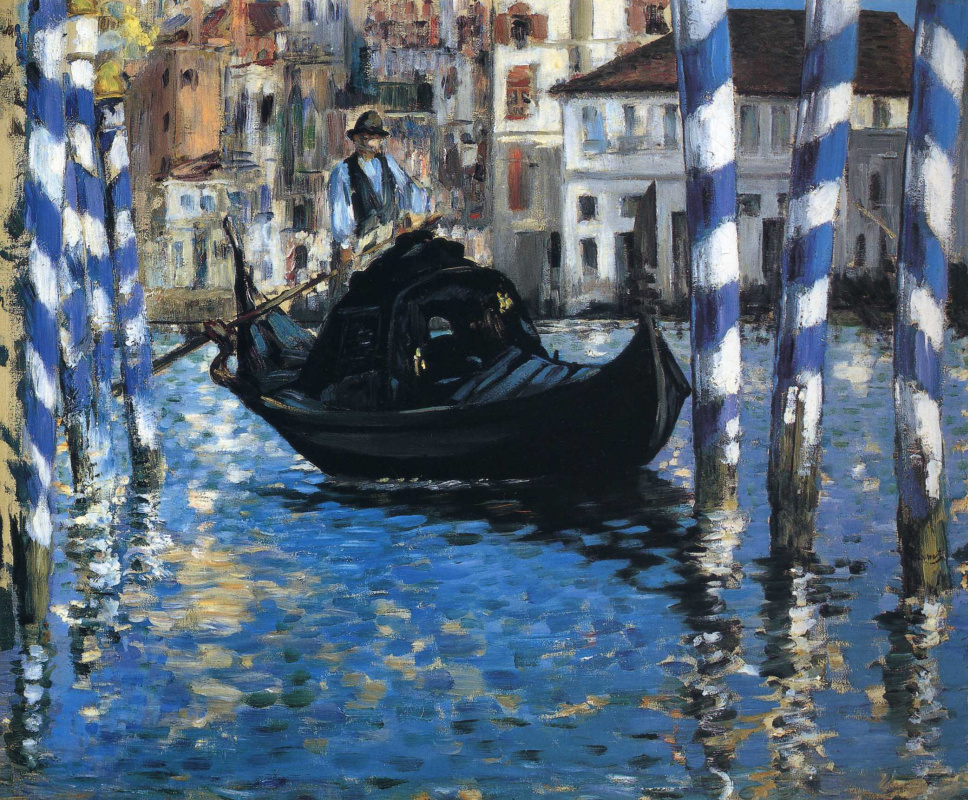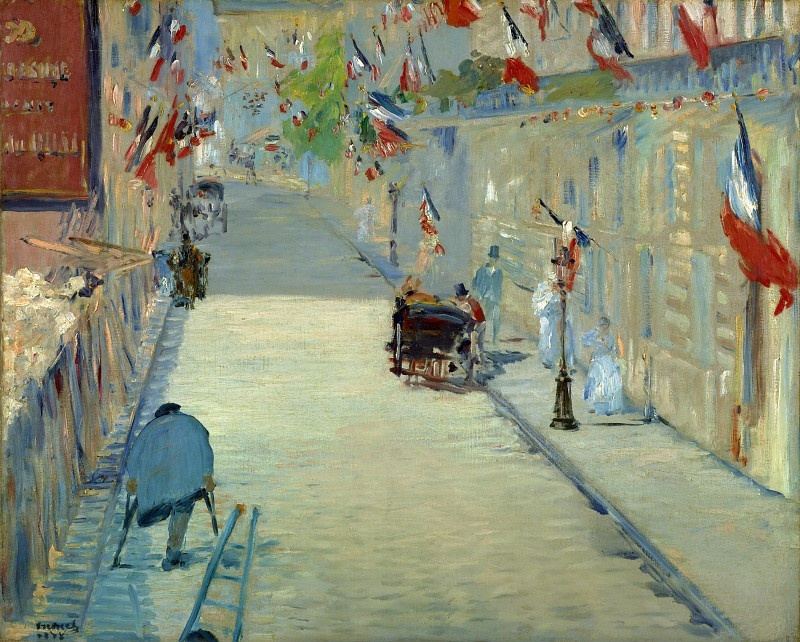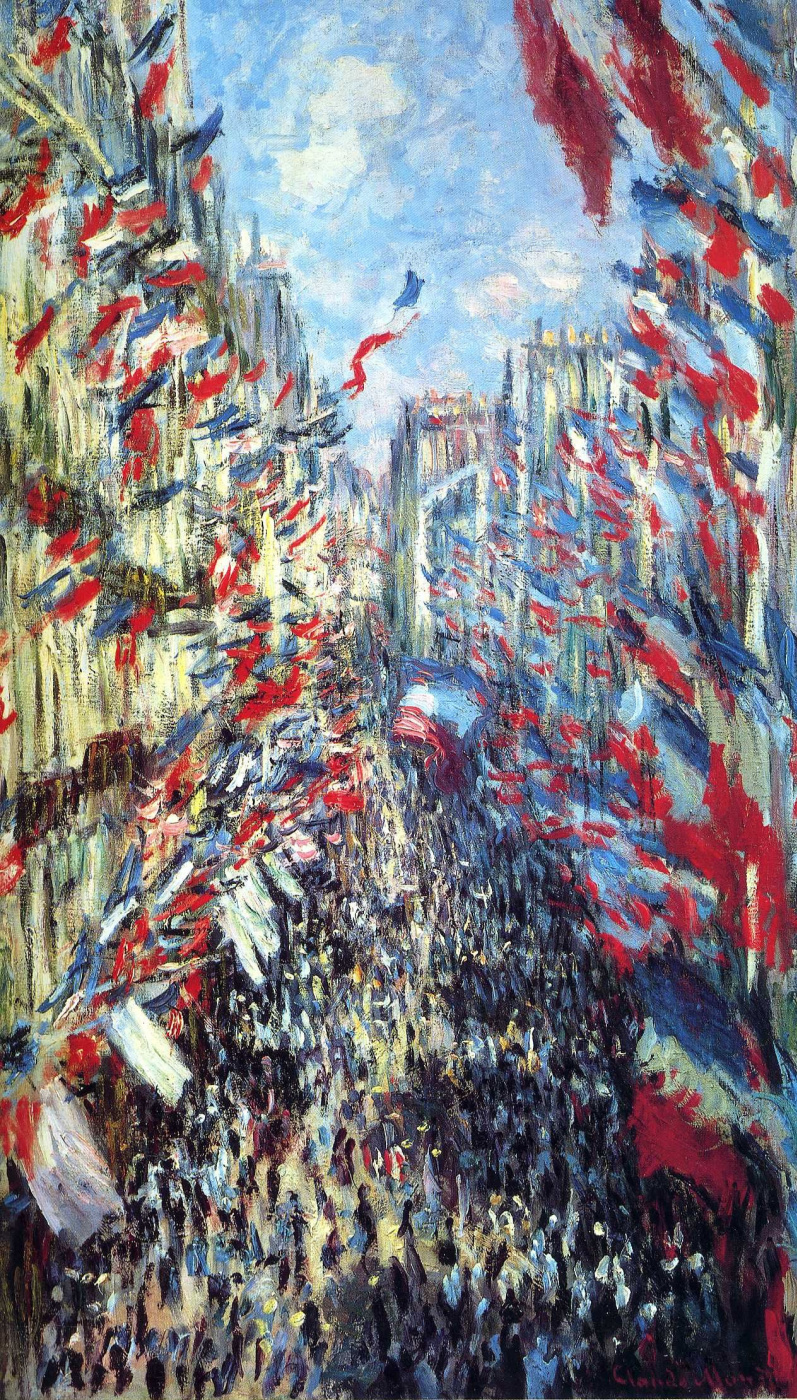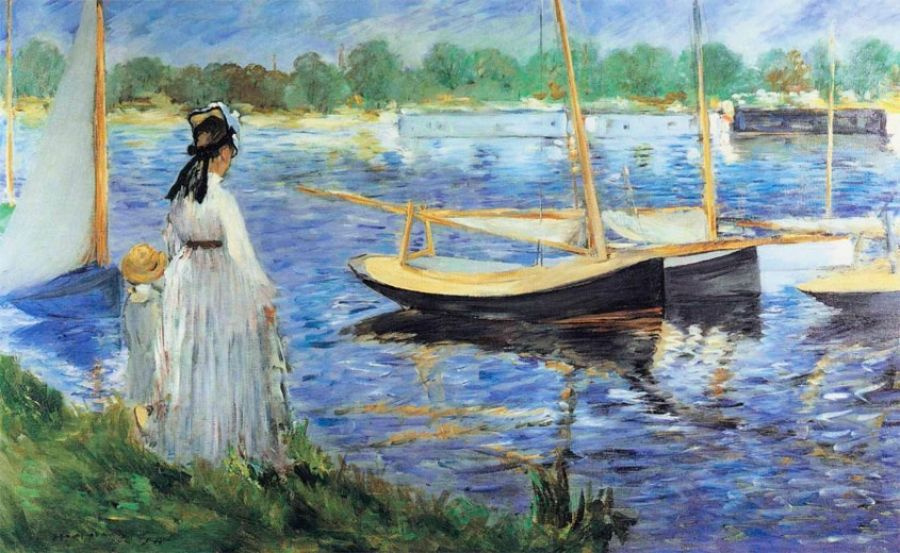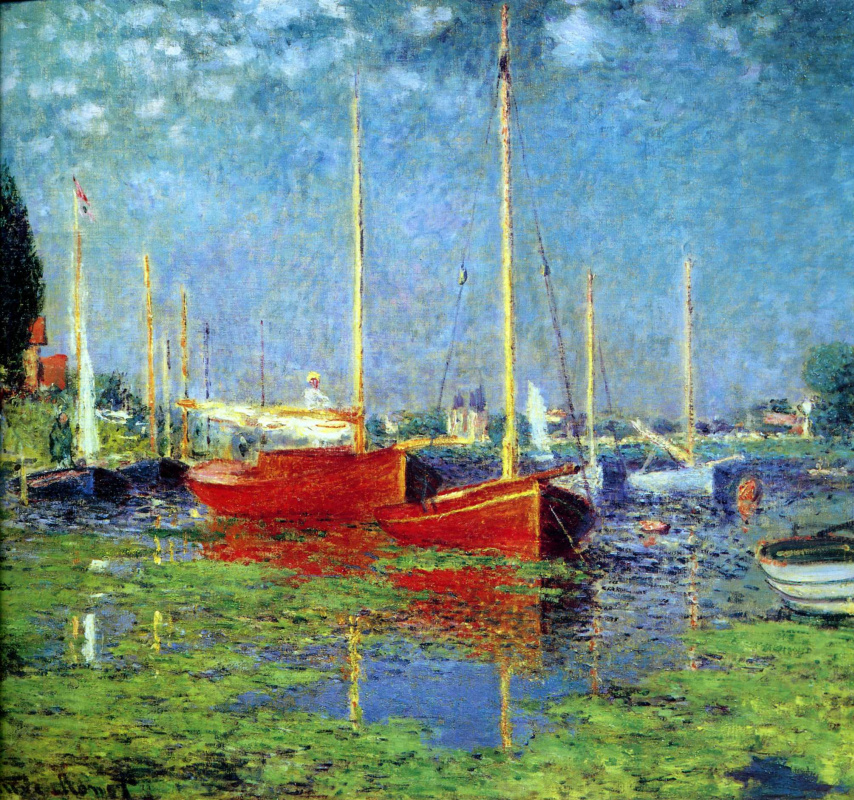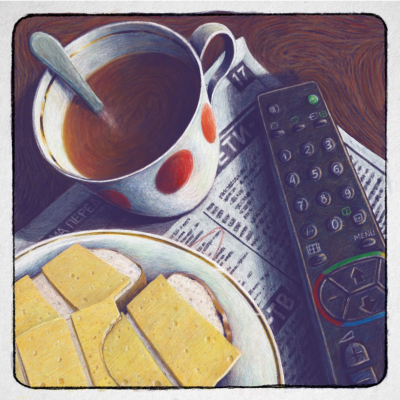The confusion with Manet and Monet names is the most obvious, but not the only reason to compare two dissimilar artists who happened to be in the same city at the same time, taking part in the same large scale exhibition and quarreled with one another at first, but then became close friends. Moreover, the history of their acquaintance started with a big conflict.

The 1865 Salon in Paris has become one of the most controversial for three hundred years since it was first organized. And it was Édouard Manet to blame. He sincerely hoped for recognition, the medal and honor, when submitting his new painting 'Olympia' to the main French exhibition. And on the grand opening day he actually heard congratulations and appraisal exclamations from everywhere in the Palace of Industry. But why the hell landscapes are mentioned? Why they praise him for some marinas? Manet was furious. It turned out that some upstart used a similar name, apparently to get his, Manet, fame! Next to his 'Olympia' and 'Jesus Mocked by the Soldiers', two landscapes were displayed by the unknown Claude Monet, who made his debut at the Salon the same year.
'Olympia' by Édouard Manet caused the scandal at the 1865 Salon. On a bed, completely naked and white as if from a morgue, clenching her hand in an indecent spasm, Olympia was addressed with the most refined and fanciful curses and comparisons. As to 25-year-old Claude Monet, he has learned lessons from his mentor Eugène Boudin perfectly and painted voluminous, dramatic clouds, not breaking the rules of tradition. Salon judges and critics still gave him their favorable nod.
Through the internet memes you can find the easiest way to differ the paintings of these two artists: Manet is people, Monet is spots. However, even a keen and advanced frequenter of museum sites, remembering for sure who painted 'Olympia' and 'Le Pont d’Argenteuil' (The Bridge at Argenteuil) will have a problem to identify where is 'The Grand Channel in Venice' by Monet and where 'The Grand Channel in Venice' by Manet.
The Grand canal in Venice
1908, 73×92 cm
The Grand Canal of Venice (Blue Venice)
1874, 71.4×58.7 cm
There are several proven ways to define accurately when spelling the last name with an "o" or an "a".
…by the might-have-been future
It is clear that no decent father (if he himself is not an artist) wants to see an artist of his son. And in the 19th century, everything was the same. Fathers of Claude Monet and Edouard Manet were similar in this. A man must mind serious business."Édouard will be a judge," - one was sure. "Claude will be a grocer," - thought the other.
8 generations of men in the family of Édouard Manet were judges and lawyers, continuing the work of their ancestors, and replacing each other in the honorary chairs of the Palace of Justice. Every day, at the same time, Auguste Manet goes out, buttoned all the buttons up, serious, polite and discreet. His youngest son Édouard demonstrates absolutely disgusting knowledge across all disciplines, except for gymnastics and drawing. He stays in the fifth grade of the most aristocratic college in Paris for two years, and cries at home from a single mention of a lawyer’s career. He is fond of drawing only, and possibly sea beckons him a little. Well, let it be a naval school, but not a bohemian life of these new-fangled artists.
When the ship 'Le Havre and Guadeloupe' with 17-year-old Édouard was sailing to Brazil from the coast of the port town of Le Havre, 9-year-old Claude Monet probably was wandering barefoot on the beach near or watching the sailing vessel from some hill where he liked to roll in grass and look at the clouds. His father keeps a shop here in Le Havre, supplying grocery to the French Navy. And Claude, when he grows up and learns in college, of course, will take over management of the family business.
Alas, all hopes of the caring father went to pieces. In college, Claude "… had learned (as best [he] could) [his] four rules of arithmetic, with a touch of spelling." And, ignoring his father’s threat to deprive him of any allowances, he went to Paris to study painting.
The same year, two paintings by 28-year-old Édouard Manet were taken at the Salon for the first time.

... by the crown
Frankly, it is easy to get confused here. Today, many would call Claude Monet the father of Impressionism. He is its founder, a king, a chief, an undisputed leader. He has got water lilies, plein air, 'Impression Sunrise', cathedrals in the mist and haystacks at all times of the day-the whole set of stylistic traits and personal discoveries. However, at first it was all quite the other way.Édouard Manet was not an Impressionist, he was not involved in any of the shows of the Anonymous Society of Painters, Sculptors, and Printmakers. But it was him whom newspaper critics and judges of the Salon disparagingly called 'the king of the Impressionists'. They also called those young artists, innovators and rebels, future impressionists, who challenged official salon traditions, as 'Manet's gang'. Oh, how much would he give to get rid of that unenviable title!
An Atelier in the Batignolles
1870, 204×273.5 cm
Édouard Manet lived in Batignolles area and often had breakfast in a "Café Guerbois" nearby. They say he loved steak with watercress and beaten eggs. Thanks to him, the district and the cafe became famous. Manet and all his young admirers (Monet, Bazille, Renoir) soon were called as "groupe des Batignolles" (The Batignolles Group). Artists, writers and journalists enthused by the idea of a new art, began to join Manet in "Café Gerbua" not to eat steak together but to talk about the fate of art.
In the painting above by Henri Fantin-Latour, Manet is surrounded by like-minded people in his studio. Young Monet still peeks shaky out from behind the shoulder of tall Basil.
In the painting above by Henri Fantin-Latour, Manet is surrounded by like-minded people in his studio. Young Monet still peeks shaky out from behind the shoulder of tall Basil.
… by the beard, gloves, cane, and hat
And it’s certainly not the point that both Manet and Monet were handsome men, although Manet had blond curly hair and Monet was a burning brunette looking like a temperamental macho. They are generally difficult to confuse: they talked, moved, dressed, and walked differently.After 'Le déjeuner sur l’herbe'(Luncheon on the Grass) and 'Olympia,' of Edouard Manet seriously thought as of a buffoon, who deliberately amused the audience with too provocative antics and earned his living by making the scandal. Emile Zola had to write a long rescuing article to assure readers that Manet was a modern bourgeois, "impeccably polite and courteous." He wrote in Le Figaro: "The artist has confessed to me that he adores society and that he found secret pleasure in the perfumed and glittering refinement of soirées. He was drawn to them by his love of bold and vivid colour; but, in his heart of hearts he had an innate need for refinement and elegance which I try hard to find in his works."
Oh, yes, Manet was a real dandy. He always wore a pair of thin leather gloves and held his unchangeable cane in his hands. His skill to tie and wear ties admired. Every day he went to a special walk; Manet sauntered. Olga Weinstein, the author of "Dandy: Fashion, literature, lifestyle," tells us that these basically vain, aimless walks had a very special meaning to the flâneur, a writer or an artist: "His route very often turns out only in the way, for the flaneur is led by a random whim. Urban space is a map of his desires, continuous sign surface, a topographic scan of his stream of consciousness. His own body reads the map, dotting the line marks of his arbitrary routes by his steps." In appearance, gait, smile, a flaneur artist determines the types of the passers-by and tries to understand what a person represents in himself/herself. Walking aimlessly, an artist searches for stories and inspiration.
Music in the Tuileries gardens
1862, 76×118 cm
Even before his 'Olympia' and 'Luncheon'', on one of these walks, Édouard Manet conceived audacity: to paint ordinary Frenchmen who walk with him through the parks and city gardens. The painting would not be accepted by the Salon. 14 years later, Pierre-Auguste Renoir will create his 'Bal du moulin de la Galette', of course, inspired by this painting of Manet.
The son of a grocer, Claude Monet was a bit crude and not born to saunter. His city walks always had one big goal, which prevents dandy’s carelessness. He pulled the tens of kilometers between the houses of friends to borrow some money. In his appearance you would never suspect that he was eating a bean bag with Renoir for a month and painted portraits for shopkeepers for 50 francs apiece. Monet managed to wear suits of English wool and shirts with lace cuffs, but he did not care about fashion and deliberately negligent knots on ties, which were knitted by the mirror for a few hours. Monet was a trendsetter himself, Monet was a socialite.
Street mosnier with flags
1878, 80×65 cm
The Rue Montorgueil in Paris, festival of 30 June 1878
1878, 81×50 cm
... by flags
Priceless museum treasures by Manet and Monet, once and for all trapped in history, are often mentioned. To distinguish views of the world between two artists, it is not necessary to finish the Academy of Arts. However, the Grand Canal in Venice is not the only subject in which easily lose orientation. For example, during the World Expo in 1878 in Paris, both artists accidentally looked out each in his window. Monet draws a colorful rampage-he paints red, white and blue holiday splendor. Flaneur Manet, though, accustomed to notice people on the streets. A one-legged, most likely, a former soldier, is slowly walking along the festive street. He no longer leaves the artist a chance to create a uniquely ceremonial painting. "I paint what I see," - Manet said. And on this day, he saw that by setting up large-scale, magnificent performances France was trying to forget about the shameful war ended seven years ago. And forgetting that, still does not work. For there is a one-legged ex-soldier wandering on a festive street.Édouard and Claude were friends until death of Manet, looked from the windows at the same Paris, walked on the same streets and the banks of the Seine, and sometimes played in artistic plays by the rules of each other.
At the Salon des Refuses in 1863, audience laughed to tears and whispered shyly in front of 'Luncheon on the Grass' by Manet. "Obscenity," the emperor would blurt out! Being in the old age, Monet has recalled how he was impressed by this painting: it was the revolt, freedom, new art, a breath of fresh air, life itself. Two years later, bowing to Manet’s genius, admiring his determination and talent, Claude painted his "Luncheon on the Grass", as a sign of respect.
Banks of the Seine at Argenteuil
1874, 62×103 cm
Argenteuil
1875, 56×67 cm
In 1874, after the first exhibition of the Impressionists, Monet was destitute and once left without a roof over his head. Édouard Manet has found his friend a house on the banks of the Seine at Argenteuil. Now, to get to each other, it was enough to cross the river. No, by no means it was a victory of the Impressionists! Manet simply could not resist to these clean, light-saturated colors on Monet’s sketches and to the shadows, full of rich reflexes. So be it, he would play in Impressionism. And he has put an easel on the water’s edge and painted his 'Argenteuil' and 'Boating,' depicted 'Monet in his Studio Boat'. "He is Rafael of the water!" Édouard admired. And still he hasn’t gone to the end with the Impressionists: he would never give herself to a purely visual delight. Light was a too simple storyline for the painting, and impressionistic incompleteness did not give Manet peace.
... by their deeds
Manet and Monet is a story of a long friendship, which was based on a huge mutual respect … and on money. In his most difficult and desperate days, Claude wrote letters to Édouard: what you’ve lent me last week, has ran out, borrow me at least 30 francs, it will save me. And Manet never refused, every year sending him 30 or 100 francs in response. When Édouard has learnt about a serious illness of Camilla, Monet’s first wife, he just wrote off all Claude’s long-term debts.In 6 years after the death of Édouard Manet, a certain American collector would come to Paris. He would have liked to buy 'Olympia' for 20 thousand franks. Monet threw his paintbrushes away for half a year and became a bookkeeper and PR specialist to organize a fund raising to purchase the canvas for the French National Museums.

Photo by www.sothebys.com
In 2011, five autograph documents with hand writing by Claude Monet were sold at Sotheby’s auction for $134,500. Among them, there was a list of contributions collected to purchase 'Olympia' by Manet. It enclosed a list of thirty-four subscribers, including Mallarmé, Mirbeau, Sargent, Caillebotte, Durand-Ruel to name just a few. Hammer price of this lot was approximately equal to the amount Monet collected during 8 months of his titanic paperwork, which finally allowed to acquire 'Olympia'.
Of course, friendship between Manet and Monet has developed not from the consonance of their names, but it seems this is the "coincidence [which] is god’s way of remaining anonymous."
Main illustration: 'Self-portrait' by Édouard Manet and 'Portrait of Claude Monet' by Renoir.
Written by: Anna Sidelnikova.
Main illustration: 'Self-portrait' by Édouard Manet and 'Portrait of Claude Monet' by Renoir.
Written by: Anna Sidelnikova.







